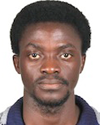Alumni

Bio
Emmanuel completed his six-year primary education in five years, received nine awards in one academic session (specifically as the overall best student in nine out of 10 subjects he studied in his fifth year of secondary education), and completed his six-year secondary education in five years. He is capable of designing scientific experiments and he has carried out research studies that got him authoring a number of scientific publications. In 2008, he got his bachelor degree in (medical) physiology, and currently studies for his PhD in the leading National University in Taiwan: National Tsing Hua University. The topmost research institute in Taiwan, Academia Sinica, supports his PhD studies/research and Professor Lee-Wei Yang advises him. His current studies and research focus on knowledge-based potentials (within the domains of structural biology), protein structure and dynamics, and computational protein design. He spends his free time designing a “search engine” (similar to, but different from, Google.) He recently built a multilingual website (http://www.leadlearners.org) for publishing scholarship information. He has leadership experiences and has held/currently holds important leadership/academic positions. For example, he served as the president (2012-2013) of the Graduate Student Association (of which the 400+ PhD students of Taiwan International Graduate Program, Academia Sinica, are members). While serving in the National Youth Service Corps (2009 -2010), he was elected as the President for the 60+ corps members serving at Ahmadu Bello University. In addition, he is an occasional reviewer for the Macedonian Journal of Medical Sciences.
Project: Development of Residue-Residue Contact Potentials for Studying Macrobiomolecules
Studying structures and dynamics of macrobiomolecules in computationally efficient manners (requiring less time, and less computation) constitute a fundamental problem in computational biology. In this project, I developed highly simplified residue-residue contact potentials (i.e. contact energies) for efficient differentiation of decoys from native structures. I started by downloading 3D structures of non-homologous protein representatives from Protein Data Bank, PDB [1]. I thereafter developed 2110 (i.e. all possible) distributions of discretized inter-residue distances. Based on the distributions, I determined the favorable separating distances between each pair of residues, and calculated the accompanying probabilities for each of the possible distances within a specified cut off. Using Maxwell-Boltzmann’s relation, I developed pseudo residue-residue potentials and applied them in computing conformation energies of proteins. I hope to improve the potentials and add some simple rules to make them more robust and good enough for studying dynamics of proteins. I will extend the method to other groups of macrobiomolecules (such as DNA, RNA, etc.).
[1] H.M. Berman, J. Westbrook, Z. Feng, G. Gilliland, T.N. Bhat, H. Weissig, I.N. Shindyalov, and B.E. Bourne, “The Protein Data Bank,” Nucleic Acids Research, 28, 2000 pp. 235-42.
Favorite Four-Color, Four State Turing Machine
Rule 1717980802923751149196
